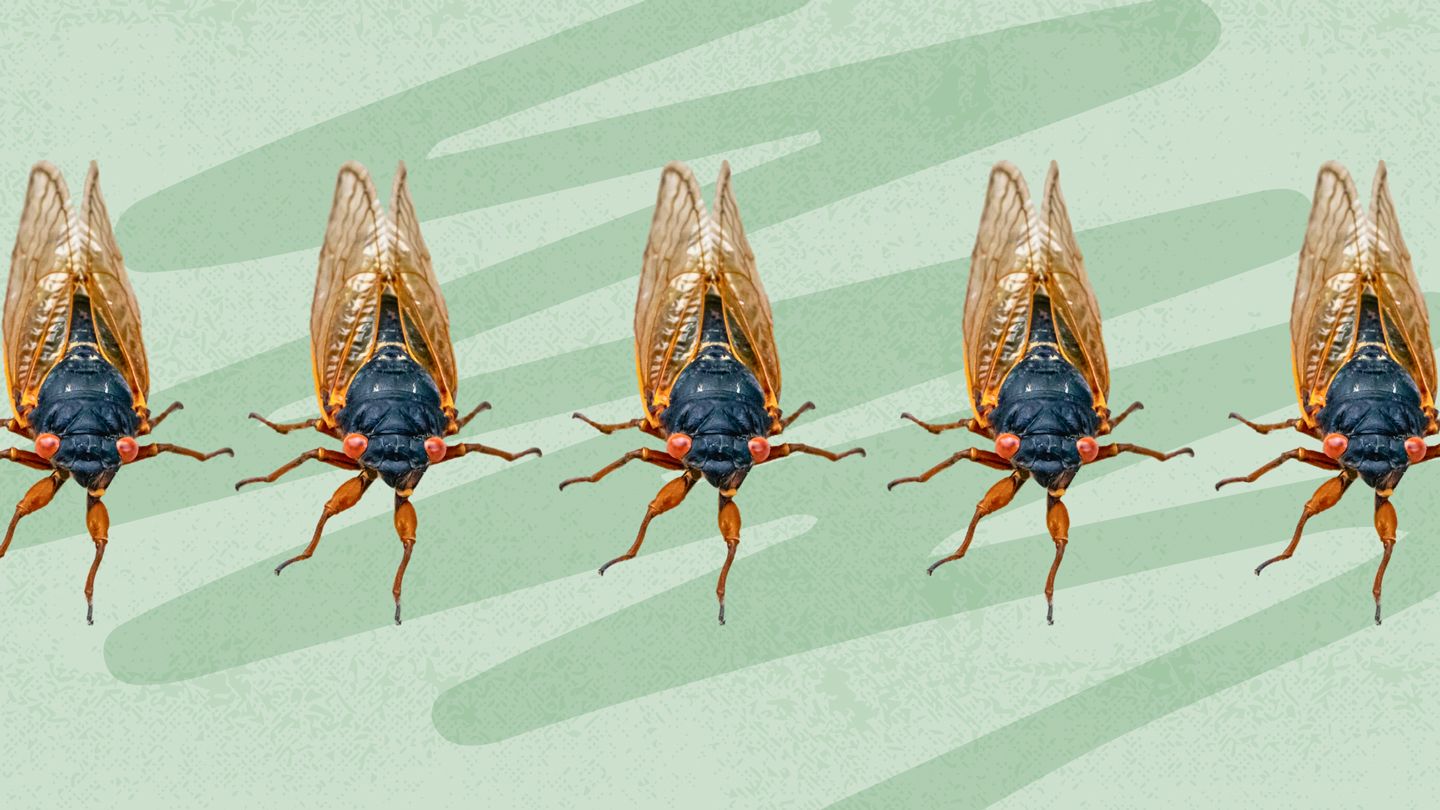Trillions of periodical cicadas — otherwise known as your favorite bug expert’s favorite bug — are emerging from the ground this spring. This group of insects, known as Brood XIV, are making their first appearance since 2008.
Experts recommend embracing the magic. In fact, the scientific name for periodical cicadas is Magicicada, so-named because these creatures perform an astounding feat: They disappear underground for many years in a regular cycle, and then suddenly reemerge.
Yet the arrival this year of so many cicadas on this 17-year cycle may have you feeling not just a little ick-ed out but also low-key nervous. You may worry that cicadas can bite, sting, or spread disease, or that their buzzing noise (they can be as loud as a hair dryer) will keep you up at night.
Experts say there’s no reason for concern and that, instead, you might consider the arrival of cicadas to be a win — especially if you choose to eat them as a crunchy, high-protein snack.
Catch Brood XIV in the next few weeks or you’ll have to wait until 2042.
Where Are You Likely to Spot the Cicadas?
Cicada broods surface when soil temperatures reach about 64 degrees, with warmer temperatures in the southern United States luring them out from underground sooner.
Chris Simon, PhD, a professor emeritus and a researcher in ecology and evolutionary biology at the University of Connecticut in Hartford, says to look for Brood XIV cicadas in the following areas:
- Tennessee
- Western North Carolina
- A small patch in north Georgia
- Parts of West Virginia
- Kentucky
- A tiny part of Western Maryland (possibly)
- Southwest Ohio
- Southeast Indiana
- Pennsylvania
- Long Island, New York
- Massachusetts
The Cicada Safari, a project that maps the emergence of Brood XIV, provides a map that shows cicadas sightings.
If you live in a state that’s seeing cicadas this year, you’re more likely to find them in places that have trees, wooded areas, or shrubs that have been present for at least 13 or 17 years, says Hannah Burrack, PhD, an applied ecologist in the department of entomology (the study of insects) at Michigan State University in East Lansing. (Some cicada broods emerge in 13-year cycles.)
“The immature nymphs [baby cicadas] are feeding on the roots of those plants. State parks, your local city park, or areas with consistent wind cover are the places where you’re most likely to have cicada populations present,” says Dr. Burrack.
Are Cicadas Loud? Will They Keep Me Up at Night?
Cicadas may be noisy enough to hear in some rural areas, says Burrack, “but if you live in a suburban or an urban environment, chances are you’re probably not going to hear anything out of the ordinary soundwise. Whatever normal insect populations you normally hear is what you’ll hear,” she says.
Besides, unless you work at night and sleep during the day, they won’t interrupt your sleep, says Burrack. “Cicadas are daytime-active insects, so they won’t make noise at night,” she says.
Can Cicadas Bite or Spread Disease?
Cicadas only feed on plants and trees, says Burrack.
“They don’t bite or sting people and they don’t spread any disease, to humans or any plant or animal that we know of,” she says.
On the off chance that a cicada lands on you, it’s probably not on purpose. They’re typically not interested in hanging out on people, and they wouldn’t stick around, Burrack says.
Can You Eat Cicadas?
“You can eat cicadas, and there are lots of recipes you can find online,” Burrack says.
- People with shellfish allergies. Cicadas are sometimes called “land shrimp,” and they are related to shellfish.
- People who are pregnant or breastfeeding. Cicadas and shellfish accumulate mercury, which can harm a developing brain.
- Young children, for the same reasons as above.
- Anyone with gout or at risk for gout. Cicadas can cause gout flare-ups.
Be mindful that cicadas may have been munching on plants with harmful pesticides or other chemicals that may not be good for you. You also don’t want to eat cicadas that are already dead or listless. Finally, don’t eat cicadas that have a white chalk bottom instead of a tail; those have a fungal infection.
What Do Cicadas Taste Like?
Do cicadas taste good? That depends on who you talk to.
What if I’m Terrified of Bugs?
Cicadas are biologically fascinating, have no negative impact on people, and are important to the ecosystem, says Burrack.
If that doesn’t ease your “ick factor,” try to keep in mind that they’re not interested in people and their emergence is relatively short-lived.
“Remember, they occur mostly in places with long-term forest and shrub growth. If you are afraid of encountering cicadas, you might not want to spend time in those areas during spring and early summer — and after that, they’ll be gone,” Burrack says.
How Long Will Cicadas Be Around?
Cicadas will be around for four to six weeks, says Burrack. “During that time they mate, lay eggs, and feed a little bit through their straw-like mouthparts,” she says.
Then they’ll either die of “cicada old age,” or be eaten by predators, she says — that’s one potential reason why they emerge in such large numbers on predictable schedules.
“The birds, reptiles, and small mammals that eat cicadas get full pretty quickly when they suddenly have hundreds of thousands of cicadas in their local habitat. So while some of them will be eaten, countless more will survive, and we think that’s really what’s driving the evolution of this unique life history,” says Burrack.
Fun Cicada Facts
Cicadas are one of the great wonders of the natural world, says Dr. Simon, and the emergence of Brood XIV is cause for excitement. “This is a great opportunity to take children to watch them emerge just after sunset and shed their skin to become adults,” she says.
How do Brood XIV cicadas know that 17 years have passed? It’s not because they’ve been hibernating; the insects are actively growing underground, says Simon.
And to grow, they have to eat. Cicada mouths are like little hypodermic needles that they insert into the roots of a tree to feed on xylem fluid, which is basically water that contains dilute nutrients. As the trees get their leaves in the spring, water evaporates from the leaves, and that pulls a column of water all the way up through the roots, trunk and branches of the tree.
“Brood” is the term used to describe a group of cicadas that reappear at the same time in the same area. Brood XIV is special, not only because of its periodic status, but also because it’s believed to be the “mother of all 17-year broods,” or the brood from which all others were derived, says Simon.
Read the full article here




